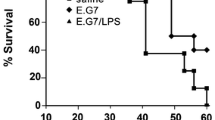Summary
Five tumor chemotherapeutic drugs: adriamycin (ADM), formyl leurosine (FLE), 1,2–5,6-dianhydrogalactitol (DAD), 5-fluorouracyl (5-FU), and vincristine (VCR) were tested for their effect on the immune response to sheep red blood cells (SRBC) in mice in the Jerne plaque assay. It was found that four of these can act as both immunostimulators and immunosuppressants, depending upon the time elapsing between their application and immunization. VCR was found to be slightly immunopotentiating.
Proper combination and timing of injections of DAD and FLE enhanced the immune response over 23fold. Administration of the same drugs in reversed sequence led to an almost complete immune suppression. Repeated injections of some drugs alone or in combination also led to marked or complete immunosuppression.
The combined use of drugs and endotoxic lipopolysaccharide (LPS) or its nontoxic, polysaccharide-rich hydrolytic breakdown product (PS) could compensate for some of the immunosuppressive effects. The most striking adjuvant effect was elicited by the combined use of VCR and LPS or VCR and the nontoxic PS preparation.
Similar content being viewed by others
References
Behling, U. H., Nowotny, A.: Immune adjuvance of lipopolysaccharide and a nontoxic hydrolytic product demonstrating oscillating effects with time. J. Immunol. 118, 1905 (1977).
Behling, U. H., Nowotny, A.: Long-term adjuvant effect of bacterial endotoxin in prevention and restoration of radiation-caused immunosuppression. Proc. Soc. Exp. Biol. Med. 157, 348 (1978).
Benjamin, E., Sluka, E.: Antikörperbildung nach experimenteller Schädigung des haemotopoetischen Systems durch Röntgenstrahlen. Wien. Klin. Wochenschr. 21, 311 (1970).
Berenbaum, M. C.: Immunosuppressive agents and the cellular kinetics of the immune response. In: Immunity, cancer and chemotherapy. Mihich, E. (ed.), p. 217. London: Academic Press 1967.
Boivin, A., Mesrobeanu, J., Mesrobeanu, L.: Technique pour la préparation des polysaccharides microbiens spécifiques. C.R. Soc. Biol. (Paris) 113, 490 (1933).
Buskirk, H. H., Crim, J. A., Petering, H. G., Merritt, K., Johnson, A. G.: Effect of uracil mustard and several antitumor drugs on the primary antibody response in rats and mice. J. Natl. Cancer Inst. 34, 747 (1965).
Chanmougan, D., Schwartz, R. S.: Enhancement of antibody synthesis by 6-mercaptopurine. J. Exp. Med. 124, 363 (1966).
Cline, N. J., Haskell, C. M.: In: Cancer chemotherapy, p. 22. Philadelphia, London, Toronto: Saunders 1975.
Dixon, F. J., McConahey, P. J.: Enhancement of antibody formation by whole body x-irradiation. J. Exp. Med. 117, 833 (1963).
Donaldson, D. M.: Response of diseased animals to ionizing radiation. In: The effects of ionizing radiations on immune processes. Leone, C. A. (ed.), p. 245. New York: Gordon and Breach 1962.
Franzl, R. E., McMaster, P. D.: The primary immune response in mice. I. The enhancement and suppression of hemolysin production by a bacterial endotoxin. J. Exp. Med. 127, 1083 (1968).
Freedman, H. H.: Selective immunosuppression of delayed hypersensitivity by oxisuram. In: Immunopharmacology. Rosenthale, M. E., Gransmann, H. C. (eds.) New York: Spectrum 1975.
Griswold, D. E., Heppner, G. H., Calabresi, P.: Selective suppression of humoral and cellular immunity with cytosine arabinoside. Cancer Res. 32, 298 (1972).
Haines, R. F., Johnson, A. G., Petering, H. G.: Variable influences of antitumor drugs and progestational agents on immune response in rodents. Fed. Proc. 26, 934 (1967).
Jerne, N. K., Nordin, A. A.: Plaque formation in agar by single antibody-producing cells. Science 140, 405 (1963).
Kaznelson, P., Lorant, J. S.: Allgemeine Leistungssteigerung als Fernwirkung therapeutischer Röntenstrahlen. Münch, Med. Wochenschr. 68, 132 (1921).
La Grange, P. H., MacKaness, G. B., Miller, T. E.: Potentiation of T-cell-mediated immunity by selective suppression of antibody formation with cyclophosphamide. J. Exp. Med. 139, 1529 (1974).
Megel, H., Raychandhuri, A., Goldstein, S., Kinsolving, C. R., Shemano, I., Michael, J. G.: Tilorone: Its selective effects on humoral and cell-mediated immunity. Proc. Soc. Exp. Biol. Med. 145, 513 (1974).
Merritt, K., Johnson, A. G.: Studies on the adjuvant of bacterial endotoxins on antibody formation. V. The influence of endotoxin and 5-fluoro-2-deoxyuridine on the primary antibody response of the BALB mouse to a purified protein antigen. J. Immunol. 91, 266 (1963).
Merritt, K., Johnson, A. G.: Types of antibody elevated by 5-fluoro-2′-deoxyuridine and endotoxin during the primary response of the mouse. Proc. Soc. Exp. Biol. Med. 115, 1132 (1964).
Nowotny, A.: Relation of structure to function in bacterial endotoxins. In: Microbiology 1977, p. 247. Washington D.C.: American Society for Microbiology 1977.
Nowotny, A., Behling, U. H., Chang, H. L.: Relation of structure to function in bacterial endotoxins. VIII. Biological activities in a polysaccharide-rich fraction. J. Immunol. 115, 199 (1975).
Petranyi, G., Nouza, K., Szollar, J., Institoris, L.: Immunosuppressive effect of cytostatic diastereomeric dibromhexitols. Folia Biol. (Praha) 15, 366 (1969).
Polak, L., Turk, J. L.: Reversal of immunological tolerance by cyclophosphamide through inhibition of suppressor cell activity. Nature 249, 654 (1974).
Santos, G. W.: Effect of syngeneic, allogeneic and parental marrow infusions in busulfan-injected rats, with a note concerning effects of busulfan on antibody production. Exp. Hematol. 9, 61 (1966).
Santos, G. W.: Immunosuppressive drugs. I. Fed. Proc. 26, 907 (1967).
Schwartz, R. (ed.): Proceedings of the Symposium on Immunosuppressive Drugs. Fed. Proc. 26, 897 (1967).
Taliaferro, W. H., Taliaferro, L. G.: Effects of X-rays on immunity: A review. J. Immunol. 66, 181 (1951).
Taliaferro, W. H., Taliaferro, L. G.: Further studies on the radiosensitive stages in hemolysin formation. J. Inf. Dis. 95, 134 (1954).
Westphal, O., Luderitz, O.: Chemische Erforschung von Lipopolysacchariden gramnegativer Bakterien. Angew. Chem. [Engl.] 66, 407 (1954).
Author information
Authors and Affiliations
Rights and permissions
About this article
Cite this article
Gaal, D., Nowotny, A. Immune enhancement by tumor-therapeutic drugs and endotoxins. Cancer Immunol Immunother 6, 9–15 (1979). https://doi.org/10.1007/BF00206011
Received:
Accepted:
Issue Date:
DOI: https://doi.org/10.1007/BF00206011



